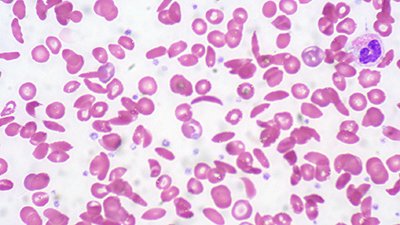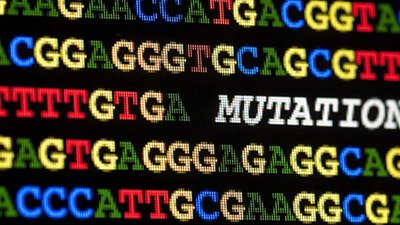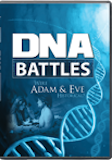Is Dark DNA Evolution’s Secret Weapon?
Dark DNA is thought to contain large regions of mutational hotspots. Such hotspots undergo high mutation rates. Since evolutionists view mutations as the genetic engine driving dramatic transformations, dark DNA could be a source of rapid and extensive evolutionary change. However, mutations have never been shown to accomplish the types of transformations required by universal common descent. Thus, dark DNA is not a special nursery for evolutionary change.
Quick Facts
- Evolution offers mutations as a mechanism for dramatic physical changes in both plants and animals.
- Some researchers suggest Dark DNA has undergone a high mutation rate, helping drive evolutionary universal common descent.
- Mutations have not been shown to account for the origin of new genes, regulatory systems, or controlling networks.
- Dark DNA does not serve as a special engine for evolutionary transformations.
To explain certain features of the universe, many astronomers have concluded that there must exist far more matter and energy than has currently been found. These hypothetical phenomena are known as dark matter and dark energy. Though there is good scientific reasoning behind their proposed existence, they have not been specifically detected. However, their existence solves certain problems with contemporary cosmological models.
In the biological world, references to “dark” substances can also be found. Microbial dark matter is a term sometimes given to microbes that are apparently in several different environments, but they have not yet been specifically cultured in a laboratory setting.1 Instead, their presence is indicated by detection of their DNA or RNA in various samplings.2
In the same manner, chromosomal DNA with no known function (aka, junk DNA) has occasionally been referred to as biological dark matter.3 It is not that this DNA is undetected, but simply its function remains undetermined. Thus, the only thing “dark” about biological dark matter is human understanding.
Dark DNA
Recently, a study has introduced the idea of dark DNA.4 Studying sand rats, researchers report finding gene activity (including RNA transcripts) apparently arising from undetected stretches of chromosomal DNA. This undetected region contained 88 genes found in other mammals, but not found in the chromosomal sequence data from the sand rat.5 Such “dark” areas of DNA appear to also be present in the chromosomes of chickens and gerbils.6
Actually, the DNA is not missing or even completely undetected. Rather, current sequencing methods frequently fail to provide an accurate sequence for some DNA segments.7 Regions of dark DNA apparently are among these unsequenced sections. Using a different approach, researchers were able to derive sequence data for some of the dark DNA regions of the sand rat.8
Several genes in this “dark DNA” appear to have a different sequence than their counterparts in other species. Among these differences, the dark DNA has a higher percentage of cytosine (C) and guanine (G).9 DNA regions with a high percentage of C and G are often more difficult to sequence, which helps explain why the sand rat sequences were not found in current chromosome sequence data banks.
One interpretation is that the dark DNA has undergone numerous mutations, which has caused its sequence to substantially differ from the analogous genes of other animals.10 These mutations resulted in an increase of C and G, making the sequences less detectable. By this interpretation, these areas of “dark DNA” may be mutational hotspots: regions where mutations occur at rates much higher than average.
From an evolutionary perspective, a high mutation rate has the potential to increase the pace of evolution. Since mutations can alter physical traits, more mutations may mean a greater variety of traits.11 The more variety of traits within a population, the more likely one (or more) of these traits will serve some benefit. This is standard Darwinism.
An evolutionary interpretation sees mutations not only as a source of unlimited physical changes, but as the engine for building new genetic systems and functions. In this framework, mutational changes drive universal common descent (i.e., all life shares a single, common ancestry). Therefore, universal common descent requires fish to evolve into amphibians and reptiles to transform into birds. Hotspots in the chromosomal DNA become a significant potential contributor to these dramatic transformations. Because of their high mutation potential, some evolutionists propose that areas of dark DNA could be “an underappreciated mechanism” driving the pace and direction of evolution.12
In fact, a New Scientist article speculates that the mutation rate of dark DNA may be so great that natural selection cannot remove the deleterious mutations fast enough.13 This would seem to pose a problem, but the article actually suggests these deleterious mutations might be useful if the organism later faces a different environment. Presumably, what was deleterious then may become beneficial.
The future benefit of deleterious mutations is sheer speculation. Even placing such speculation aside, deleterious mutations are, by definition, harmful to the organism. Some may be more harmful than others. Yet, the more that deleterious mutations accumulate within members of a population, the more of a threat they become to the overall health of that population. Therefore, within the context presented by the New Scientist article, dark DNA is more likely to drive a population to extinction than to serve as an engine driving the next evolutionary step.
Fisher’s Theorem
In his classic theorem, Ronald Fisher apparently thought that a constant input of new mutations will assure populations have unlimited potential of genetic variation.14 He assumed this unlimited variation enables populations to constantly increase in fitness. Fisher considered his work a mathematical proof for Darwinian evolution.
In actuality, high mutation rates usually cause a decline of population fitness, especially in smaller populations.
However, Fisher did not actually account for the effects of mutation rate on a population. Rather, he assumed beneficial mutations were relatively common. He further assumed that animal populations will reach an equilibrium where deleterious mutations are removed at the same rate that new mutations occur.15 Even today, Fisher’s calculations are still considered a cornerstone of neo-Darwinism.
In actuality, high mutation rates usually cause a decline of population fitness, especially in smaller populations.16 Larger populations fare little better; a steady input of mutations can still have a negative fitness effect. Plus, beneficial mutations are not common, as Fisher assumed, but are actually rather rare.17 Fisher’s assumption of an equilibrium of negative mutations is also now known to be wrong.18
Mutations and Evolution
More to the point, mutations simply do not provide the types of genetic changes required by universal common descent. Despite a steady stream of bravado from the evolutionist community, there is a general failure to demonstrate how mutations explain the origin of basic biologic systems, such as lungs, eyes, legs, and wings. Examples of mutations achieving the types of transformations necessary for universal descent are distinctly absent.19
Even beneficial mutations (i.e., those providing a selective advantage), are typically degenerative.20 Pre-existing systems are usually eliminated or inhibited. The effect may be of benefit to the organism (e.g., provide antibiotic resistance, HIV resistance, or improved digestion of lactose), but such benefits are at the expense of pre-existing genetic functions. This is the opposite of what is required for universal common descent.
Dark DNA is not a special site for evolutionary change. It is not a newly discovered Darwinian weapon.
If mutations do not generate the type of genetic systems and events necessary to drive common descent, then hotspots in the chromosomal DNA are not an “underappreciated” mechanism for evolution. They may be an interesting site of limited changes and adaptation, but they do not provide a nursery for new genes, new regulatory systems, and new network controls.
Thus, dark DNA is not a special site for evolutionary change. It is not a newly discovered Darwinian weapon. If dark DNA produces detrimental mutations faster than they are eliminated, then dark DNA would ultimately be a detriment to the population.
These areas of DNA may have a higher mutation rate, but evolutionists have not yet demonstrated how those mutations contribute to the origin of key transformational stages (e.g., vertebrates from invertebrates or the origin of reptile legs). Rather than giving a robust insight into biological origins, evolution offers little in the way of explanation.
Footnotes
- University of Tennessee at Knoxville, “Microbial dark matter dominates Earth’s environments,” Lab Manager, September 26, 2018, https://www.labmanager.com/news/2018/09/microbial-dark-matter-dominates-earth-s-environments.
- Laura A. Hug, “Sizing up the uncultured microbial majority,” mSystems, 3:5:e00185-18, doi:10.1128/mSystems.00185-18, https://msystems.asm.org/content/3/5/e00185-18.
- Rebecca Boyle, “Inside the Mysterious Dark Matter of the Human Genome,” Popular Science, September 6, 2012, https://www.popsci.com/science/article/2012-09/encode-project-sheds-light-human-genomes-dark-matter.
- Adam Hargreaves, L. Zhou, J. Christensen, F. Marlétaz, S. Liu, F. Li, P.G. Jansen, E. Spiga, M.T. Hansen, S. V. H. Pedersen, S. Biswas, K. Serikawa, B.A. Fox, W.R. Taylor, J.F. Mulley, G. Zhang, R.S. Heller, and P.W.H. Holland, “Genome sequence of a diabetes-prone rodent reveals a mutation hotspot around the ParaHox gene cluster.” Proceedings of the National Academy of Sciences, July 18, 2017, USA 114:7677–7682, doi:10.1073/pnas.1702930114.
- Ibid.
Ibid. And Adam Hargreaves, “Dark DNA: The missing matter at the heart of nature,” New Scientist, March, 7, 2018, https://www.newscientist.com/article/mg23731680-200-dark-dna-the-missing-matter-at-the-heart-of-nature/.
- There are several potential reasons for this failure. Current sequencing methods struggle with regions that are loaded with cytosine (C) and quinine (Q) nucleotides, or long DNA regions that contain numerous sequence repeats (e.q., numerous repeats of AGAGAGAG). Areas containing what are known as hairpin structures and areas containing long homopolymer sequences (e.q., AAAAAAAAAAAAAAAAAA) are also more difficult to accurately sequence. As sequencing technology continues to develop, such DNA regions will present less of a problem.
- Hargreaves, “Genome sequence of diabetes-prone rodent.”
- Hargreaves, “Genome sequence of diabetes-prone rodent.”
- Hargreaves, “Dark DNA.”
Shane Wright, Jeannette Keeling, and Len Gillman, “The road from Santa Rosalia: A faster tempo of evolution in tropical climates,” Proceedings of the National Academy of Sciences, USA 103 (2006):20:7718–7722, doi:10.1073/pnas.0510383103, http://www.pnas.org/content/103/20/7718.
Lindell Bromham, “Why do some species vary in their rate of molecular evolution?” Biology Letters, doi:10.1098/rsbl.2009.0136, April 9, 2009, http://rsbl.royalsocietypublishing.org/content/5/3/401.
Marta Lourenco, R.S. Ramiro, D. Güleresi, J. Barroso-Batista, K.B. Xavier, I. Gordo, and A. Sousa, “A Mutational Hotspot and Strong Selection Contribute to the Order of Mutations Selected for during Escherichia coli Adaptation to the Gut,” PLoS Genetics 12, no. 11 (2016): e1006420, doi:10.1371/journal.pgen.1006420, https://journals.plos.org/plosgenetics/article?id=10.1371/journal.pgen.1006420.
Adam Hargreaves, “Introducing ‘dark DNA’—the phenomenon that could change how we think about evolution,” The Conversation, accessed September 21, 2018, https://theconversation.com/introducing-dark-dna-the-phenomenon-that-could-change-how-we-think-about-evolution-82867.
How underappreciated these hotspots are in evolution-think is a matter of opinion. For example, see Judge Starling, “The dark side of the newest “Dark DNA” on the block,” accessed September 11, 2018, http://judgestarling.tumblr.com/post/172663497961/the-dark-side-of-the-newest-dark-dna-on-the.
- Hargreaves, “Dark DNA.”
- Ronald Fisher, The Genetical Theory of Natural Selection, (Oxford, Great Britain, Clarendon Press, 1930).
- Fisher, The Genetical Theory of Natural Selection.
- William F. Basener and John C. Sanford, “The fundamental theorem of natural selection with mutations,” Mathematical Biology 76 (2018): 1589-1622, doi:10.1007/s00285-017-1190-x, https://www.ncbi.nlm.nih.gov/pmc/articles/PMC5906570/.
- John C. Sanford, Genetic Entropy, (Warerloo, NY: FMS Publication, 2014).
- Ibid.
Kevin Anderson, “Citrate utilizing mutants of Escherichia coli,” Creation Research Society Quarterly 52 (2016): 309–324.
Kevin Anderson, “How Are New Genes Made?” Answers in Depth 11 (2016), https://answersingenesis.org/genetics/how-are-new-genes-made/
Kevin Anderson, “Could Life Have Evolved Multicellular Systems?” Answers in Depth 11 (2016), https://answersingenesis.org/origin-of-life/could-life-have-evolved-multicellular-systems/
Kevin Anderson, “The Challenge of Mount Improbable,” Creation Research Society Quarterly 52 (2016):244–248.
Kevin Anderson, “Genetic Insights Into Human Origins,” edited by D.R. Bundrick and S. Badger, Genesis & Genetics, Proceedings of the 2014 Faith & Science Conference, (Springfield, MO: Gospel Publishing House, 2014), pp. 79–96.
Recommended Resources

Answers in Genesis is an apologetics ministry, dedicated to helping Christians defend their faith and proclaim the good news of Jesus Christ.
- Customer Service 800.778.3390
- © 2024 Answers in Genesis







